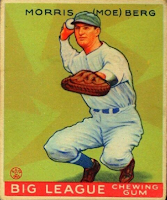John Francis Moore
Philadelphia Phillies
Outfield
Born: March 23, 1902, Waterville, CT
Major League Teams: Chicago Cubs 1928-1929, 1931-1932; Cincinnati Reds 1933-1934; Philadelphia Phillies 1934-1937; Chicago Cubs 1945
World Series Appearances: Chicago Cubs 1932
Died: April 4, 1991, Bradenton, FL (89)
Johnny Moore quietly enjoyed a productive major league career, playing in parts of 10 seasons with the Cubs, Reds and Phillies. First given the chance to play every day in 1932 at the age of 30, Moore was the regular center fielder for the Cubs and he batted over .300 for the first of five seasons during his career. After a full season with the Reds in 1933, he was dealt to the Phillies where he again quietly put up solid offensive numbers while playing right and then left field regularly for the club between 1934 and 1937. Moore's best season came in 1934 when he batted .343 for the Phillies with 11 home runs and 93 RBIs. Combined with his 16 games with the Reds early that season, Moore drove in a career high 98 runs. He'd repeat that success in 1935, batting .323 with 19 home runs (a career high) and 93 RBIs. Injuries and the need for Phillies owner Gerry Nugent to find cash led to Moore being sold to the Los Angeles Angels in the Pacific Coast League following the 1937 season.
 |
| 1937 Wheaties Series 9 |
Building the Set
December 16, 2020 from Albion, NY
Within days of officially deciding to collect the Diamond Stars set, I found myself searching for the 1993 extension set consisting of 36 more "what if" cards this time issued by the Chicle Fantasy Company. Individual cards from this set are very prevalent on eBay, but I wanted to buy a complete set to save myself some time and money. Given this is a relatively modern set, I was somewhat surprised at the closing auction prices for previously sold complete sets and I was happy to win my set at a lower price. These cards are gorgeous, and I can tell a lot of hard work and love for the originals went into making this tribute set. What's more, the set's creators were smart enough to start the numbering with card #120, given the 1981 extension set had left off with #120.
As I slowly collect the originals from the 1930s, I'll also highlight each of the cards from these extension sets with their own posts.
Variations Available
1 - 1993 / blue back / no statistics / 1993 copyright
The Card / Phillies Team Set
For such a productive player from his era, Moore's baseball card appearances overall from his playing days were scarce. The narrative on the back of the card does a great job summarizing Moore's resiliency in sticking around in the minor leagues early in his career, and that resiliency would continue throughout his playing days.
1936 Season
The Phillies, long a second division club, finished the 1936 season with a 54-100 record under player-manager Jimmie Wilson (#22). Moore appeared in 124 games, batting a team-leading .328 while hitting 16 home runs and driving in 68. On July 22nd, Moore enjoyed a three home run day against the Pirates at the Baker Bowl, going 4 for 5 overall with six RBIs and four runs scored. Moore started 74 games in left field and 32 games in right field as manager Wilson attempted to jump start his offense with outfield combinations consisting of Moore, Ernie Sulik, Lou Chiozza (#80) or the re-acquired Chuck Klein (#139).
Phillies Career
Moore was acquired from the Reds on May 16, 1934, with Syl Johnson for Ten Kleinhans, Art Ruble and Wes Schulmerich. He'd lead the team three seasons in a row (1934-1936) in batting, while supplying a generous supply of power. His 19 home runs in 1935 were second on the club behind first baseman Dolph Camilli, who had 25. Moore received MVP votes in 1935, finishing 15th in the final tally. In 489 games with the Phillies, he batted. .329 with 55 home runs and 313 RBIs, providing a bright spot for the franchise during one of their many lengthy bad stretches.
|
|
|
Other Notable Baseball Cards
First Mainstream Card: 1934 Butterfinger (R310) #45
Topps Flagship Set Appearances (0): N/A
Most Recent Mainstream Card: 1994 Conlon Collection TSN #1184
15 - Moore non-parallel baseball cards in the Beckett online database as of 12/10/21.
Sources:
Previous Card: #145 Johnny Mize - St. Louis Cardinals
Next Card: #147 Hugh Mulcahy - Philadelphia Phillies






















































